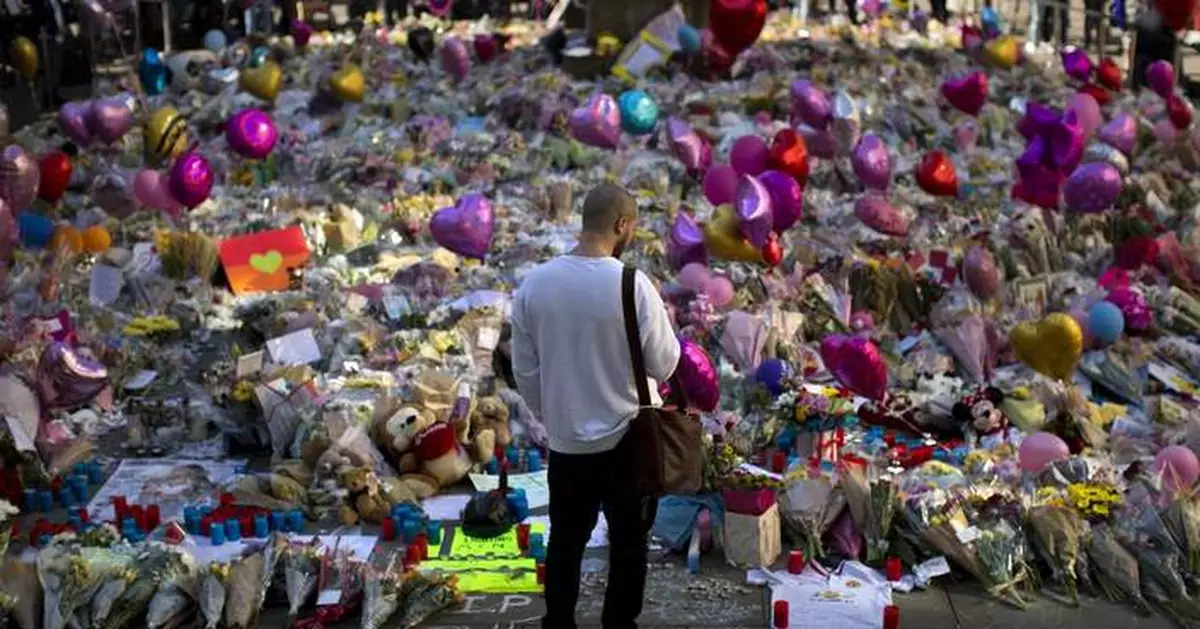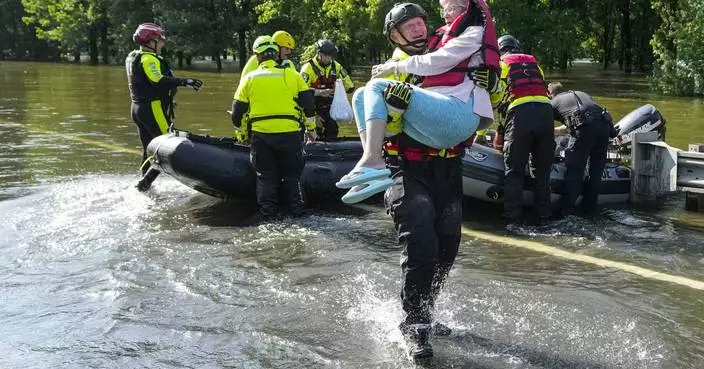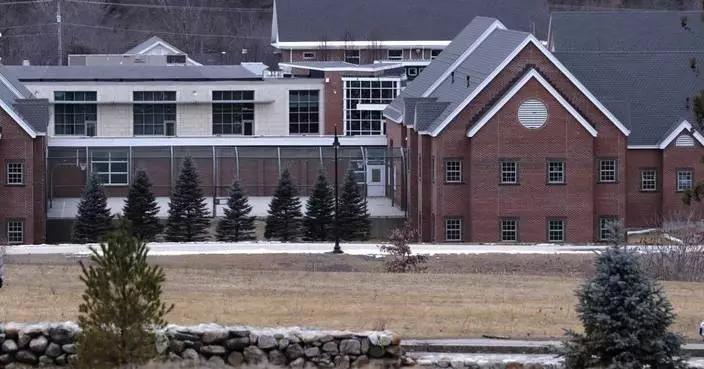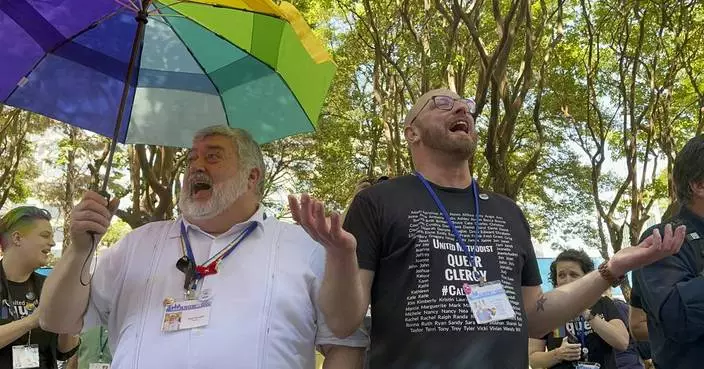LONDON (AP) — More than 250 survivors of the bombing that killed 22 people at a 2017 Ariana Grande concert in Manchester, England, are taking legal action against Britain's domestic intelligence agency, lawyers said.
Lawyers from three law firms said Sunday they have submitted a group claim on behalf of more than 250 clients to the U.K.'s investigatory powers tribunal. They said they could not provide further details because it was an ongoing legal matter.
Suicide bomber Salman Abedi set up a knapsack bomb in Manchester Arena at the end of Grande's concert on May 22, 2017, as thousands of young fans were leaving. More than 100 people were injured, many of them children and teenagers. Abedi died in the explosion.
An official inquiry reported last year that Britain's domestic intelligence agency, MI5, didn’t act swiftly enough on key information and missed a significant opportunity to prevent the bombing, the deadliest extremist attack in the U.K. in recent years.
Abedi had been a “subject of interest” to MI5 officials in 2014, but his case was closed shortly after because he was deemed to be low risk.
The report also found that one MI5 officer admitted they considered intelligence about Abedi to be a possible national security concern, but didn’t discuss it with colleagues quickly enough.
Ken McCallum, the head of MI5, said in a rare televised statement that he was “profoundly sorry” his agency was unable to prevent the attack.

FILE - Flower tributes are seen at St Ann's Square, Manchester, England, May 23, 2017, after a suicide bombing attack at an Ariana Grande concert at the Manchester Arena. More than 250 survivors of the suicide bombing that killed 22 people at a 2017 Ariana Grande concert in Manchester, England, are taking legal action against Britain's domestic intelligence agency, lawyers said Sunday, April 14, 2024. (AP Photo/Rui Vieira, File)

FILE - Ariana Grande appears at the 62nd annual Grammy Awards in Los Angeles, Jan. 26, 2020. More than 250 survivors of the suicide bombing that killed 22 people at a 2017 Ariana Grande concert in Manchester, England, are taking legal action against Britain's domestic intelligence agency, lawyers said Sunday, April 14, 2024. (Photo by Jordan Strauss/Invision/AP, File)

FILE - A man stands next to flowers for the victims of a bombing at St. Ann's Square in central Manchester, England, May 26, 2017. More than 250 survivors of the suicide bombing that killed 22 people at a 2017 Ariana Grande concert in Manchester, England, are taking legal action against Britain's domestic intelligence agency, lawyers said Sunday, April 14, 2024. (AP Photo/Emilio Morenatti, File)
FITZGERALD, Georgia (AP) — On-the-ground preparations are on track in Gaza for humanitarian workers to be ready to deliver food, treatment for starving children and other urgent assistance by early or mid-May when the American military expects to finish building a floating pier to receive the shipments, a U.S. Agency for International Development official said Friday.
Ramping up the delivery of aid on a planned U.S.-backed sea route will be gradual as aid groups test the distribution and security arrangements for relief workers, the USAID official told The Associated Press.
The official spoke on condition of anonymity over security concerns for work done in a conflict zone. They were some of the agency’s first comments on the status of preparations for the Biden administration’s $320 million Gaza pier project, for which USAID is helping coordinate on-the-ground security and distribution.
Meanwhile, at a factory in rural Georgia on Friday, USAID Administrator Samantha Power pointed to the food crises in Gaza and other parts of the world as she announced a $200 million investment aimed at increasing production of emergency nutritional paste for starving children under 5.
Power spoke to factory workers, peanut farmers and local dignitaries sitting among pallets of the paste at the Mana nonprofit in Fitzgerald. It is one of two factories in the U.S. that produces the nutritional food, which is used in clinical settings and made from ground peanuts, powdered milk, sugar and oil, ready to eat in plastic pouches resembling large ketchup packets.
“This effort, this vision meets the moment,” Power said. "And it could not be more timely, more necessary or more important.”
With the Israel-Hamas war stretching close to seven months and Israel restricting humanitarian aid, half of Gaza's 2.3 million people are at imminent risk of famine, international health officials say. Under pressure from the U.S. and others, Israeli officials in recent weeks have begun slowly reopening some border crossings for relief shipments.
But aid coming through the sea route, once it's operational, still will serve only a fraction — half a million people — of those who need help in Gaza. Aid organizations including USAID stress that getting more aid through border crossings is essential to staving off famine in the territory.
Children under 5 are among the first to die when wars, droughts or other disasters curtail food. Hospital officials in northern Gaza reported the first deaths from hunger in early March and said most of the dead were children.
The panel that serves as the internationally recognized monitor for food crises said earlier this year that northern Gaza was on the brink of famine and likely to experience it by this month. While the next update will not come before this summer, it's clear that so far there has not been enough food getting to north Gaza to avert famine, the USAID official said.
Power said the U.N. has called for 400 metric tons of the nutritional paste in the Palestinian territory “in light of the severe hunger that is pervading across Gaza right now, and the severe, acute humanitarian crisis.” USAID expects to provide a quarter of that, she said.
Globally, she said at the Georgia factory, the treatment made there “will save untold lives, millions of lives.”
USAID is coordinating with the U.N. World Food Program and other humanitarian partners and governments on security and distribution for the pier project, while U.S. military forces finish building it. President Joe Biden, under pressure to do more to ease the humanitarian catastrophe in Gaza as the U.S. provides military support for Israel, announced the project in early March.
U.S. Central Command said in a statement Friday that offshore assembly of the floating pier has been temporarily paused due to high winds and sea swells, which caused unsafe conditions for soldiers. The partially built pier and the military vessels involved have gone to Israel's Port of Ashdod, where the work will continue.
A U.S. official said the high seas will delay the installation for several days, possibly until later next week. The official, who spoke on condition of anonymity to discuss operation details, said the pause could last longer if the bad weather continues because military personnel and divers have to get into the water for the final installation.
The United Nations has been muted about its role in the aid deliveries.
“We want to see more land operations. This is a sea operation," U.N. spokesman Stephane Dujarric said Wednesday. "We are working with them, but obviously we have certain parameters that need to be respected, notably the basic humanitarian principles that we have of independence and being free from all sorts of military.”
The struggles this week with the first aid delivery through a newly reopened land corridor into north Gaza underscored the uncertainty about security and the danger still facing relief workers. Israeli settlers blocked the convoy before it crossed Wednesday. Once inside Gaza, the convoy was commandeered by Hamas militants, before U.N. officials reclaimed it.
In Gaza, the nutritional treatment for starving children is most urgently needed in the northern part of the Palestinian territory. Civilians have been cut off from most aid supplies, bombarded by Israeli airstrikes and driven into hiding by fighting.
Acute malnutrition rates among children under 5 have surged from 1% before the war to 30% five months later, the USAID official said. The official called it the fastest such climb in hunger in recent history, more than in grave conflicts and food shortages in Somalia or South Sudan.
One of the few medical facilities still operating in northern Gaza, Kamal Adwan hospital, is besieged by parents bringing in thousands of children with malnutrition for treatment, the official said. Aid officials believe many more starving children remain unseen and in need, with families unable to bring them through fighting and checkpoints for care.
Saving the gravely malnourished children in particular requires both greatly increased deliveries of aid and sustained calm in fighting, the official said, so that aid workers can set up treatment facilities around the territory and families can safely bring children in for the sustained treatment needed.
Knickmeyer reported from Washington. Associated Press writers Lolita C. Baldor in Washington and Edith M. Lederer at the United Nations contributed.

USAID Administrator Samantha Power speaks with U.S. Rep. Austin Scott on Friday, May 3, 2024, during a tour of the factory where the nonprofit Mana produces emergency nutritional aid in Fizgerald, Ga. Power announced USAID is investing $200 million in emergency food aid for children in Gaza, Sudan and other countries where conflict has driven up need. AP Photo by Russ Bynum Sent from my iPhone

USAID Administrator Samantha Power talks with a worker Friday, May 3, 2024, during a tour of the factory where the nonprofit Mana makes emergency nutritional aid in Fitzgerald, Georgia. Power announced USAID is investing $200 million in emergency nutritional treatment for starving children as conflicts in Gaza, Sudan and elsewhere drive up the need. (AP Photo/Russ Bynum)

USAID Administrator Samantha Power talks with Mana operations director Harry Broughton during a tour of its factory in Fitzgerald, Ga., that produces emergency nutritional aid for starving children, on Friday, May 3, 2024. Power announced USAID is investing $200 million to increase nutritional aid for starving children in Gaza, Sudan and other places where conflict has increased needs. (AP Photo/Russ Bynum)

In this image provided by the U.S. Army, soldiers assigned to the 7th Transportation Brigade (Expeditionary) and sailors attached to the MV Roy P. Benavidez assemble the Roll-On, Roll-Off Distribution Facility (RRDF), or floating pier, off the shore of Gaza on April 26, 2024. The U.S. expects to have on-the-ground arrangements in Gaza ready for humanitarian workers to start delivering aid this month via a new U.S.-backed sea route for Gaza aid. An official with the U.S. Agency for International Development tells the AP that humanitarian groups expect to have their part of preparations complete by early to mid-month. (U.S. Army via AP)
















